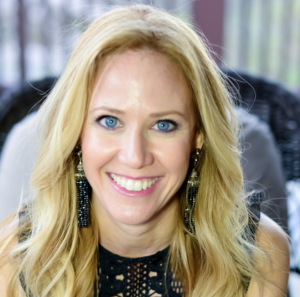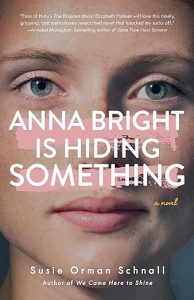WHAT’S THE BIG IDEA: How Authors Find Ideas for Their Novels
by Susie Orman Schnall, author of ANNA BRIGHT IS HIDING SOMETHING
 In Big Magic, Elizabeth Gilbert talks about how ideas can be understood as living things. That a stagnant idea in one author’s imagination can “travel” to another author to become fully realized. Such was the case when Gilbert struggled with an idea for a novel set in the Amazon (jungle, not book warehouse). That idea eventually became Patchett’s State of Wonder.
In Big Magic, Elizabeth Gilbert talks about how ideas can be understood as living things. That a stagnant idea in one author’s imagination can “travel” to another author to become fully realized. Such was the case when Gilbert struggled with an idea for a novel set in the Amazon (jungle, not book warehouse). That idea eventually became Patchett’s State of Wonder.
That’s certainly one way for an author to get an idea. And that process—the original spark of a novel—is a source of great curiosity from readers who unfailingly ask authors at book talks how they came up with the idea for a particular work.
Jo Piazza created The Sicilian Inheritance from family lore passed down through generations. Ariel Lawhon learned about long-forgotten midwife Martha Ballard in a devotional she read in her OB’s office, which led to her writing of The Frozen River. Amanda Peters got the idea for The Berry Pickers while visiting a blueberry field in Maine with her father and hearing about his childhood experiences picking berries with his family.
I’ve gotten the ideas for my own five novels in five different ways. Here’s the story for each and then I share ideas for writers to glean ideas themselves.
ANNA BRIGHT IS HIDING SOMETHING
The idea for my newest novel, set in the fascinating world of female entrepreneurs, came from two places. First, from my own fascination with the rise and fall of female founders and the ecosystem of this world that I read about daily in Fortune’s The Broadsheet newsletter and other outlets. Second, from reading Bad Blood: Secrets and Lies in a Silicon Valley Startup by Wall Street Journal reporter John Carreyrou’s about the fraud committed by Elizabeth Holmes of Theranos. I thought it would be interesting to explore that world, and those types of women, through fiction.
WE CAME HERE TO SHINE
This historical novel is set during the 1939 New York World’s Fair and has as one of its main characters, a swimmer in the Aquacade, which was a synchronized swimming spectacular that was one of the fair’s hightest grossing attractions. While reading the autobiography of Esther Williams, I learned that, when she was 19, she auditioned for the Aquacade. Wait, Aquacade? What’s an Aquacade? I looked it up online and went down a rabbit hole of learning about the 1939 New York World’s Fair and thought it would be a fascinating setting for two ambitious women to spend a summer of discovery.
THE SUBWAY GIRLS
I was listening to NPR and a story came on about the Miss Subways beauty contest that ran in the NYC subway system from 1941-1976. I was captivated. A beauty pageant held in the subways? I immediately went home and learned more about this fascinating program which became the basis for my dual timeline novel about a woman competing in 1949 to become Miss Subways and a modern day woman who learns about the contest while researching an advertising pitch. The two storylines intersect and the world of Miss Subways takes center stage.
THE BALANCE PROJECT
Back when my three boys were really young, I struggled with how to be the type of mother that felt right to me while also having a professional identity. I decided to ask women—who seemed to know the secret—how they were “doing it all.” Those questions turned into my popular interview series “The Balance Project” which then morphed into my novel The Balance Project where I explore the concept through fiction. It was my own curiosity and passion for the topic that led me to want to write about all of its angles.
ON GRACE
They always say write what you know. While deciding what to write about for my first novel, what I knew was that I was on the verge of 40 and about to watch my youngest child start kindergarten. That became the spark for On Grace, a novel mostly about reentering the workforce after children but also about rediscovering oneself.
So, my ideas came from the news, a book, the radio, and issues I was dealing with in my own life. Each one sparked curiosity that led me to want to learn more about a topic and eventually write about it. Not every idea is novel-worthy. I have several unfinished novels to prove that fact. But if something strikes you, if your exploration of the topic seems perfect or a novel, and if it’s an idea you want to be absorbed in for the years it takes to write, publish, and promote a book, then you may have the start of your best work yet!
Are you a writer struggling with coming up with an idea for a novel. Try one of these…
The News
Look through old newspapers to find stories, settings, or real people that spark your interest. Build a novel around one of those.
Your Family
Every family has a fascinating story either in current generations or in stories passed down from past generations. Tap into those.
Other Books/Movies/Shows
High concept novels are often described as This Book meets That Book or This Movie meets That Podcast. Think of other IP you love and try to find a way to meld them to come up with something new.
Travel
Use a place, a people, or an experience from your travels to spark an idea for a story.
How have you come up with your ideas? Find me on Instagram @susieormanschnall and let me know!
Susie Orman Schnall is the author of five novels about ambitious women: Anna Bright Is Hiding Something (2023), We Came Here to Shine(2020), The Subway Girls (2018), The Balance Project (2015), and On Grace (2014). She’s also a screenwriter currently shopping her first pilot and feature-length screenplay. A mother of three sons, Susie grew up in Los Angeles, graduated from the University of Pennsylvania, and now lives with her husband in New York. When she’s not reading or writing you can find her doing a crossword puzzle, playing around on Canva, or hiking to the top of a mountain.
ANNA BRIGHT IS HIDING SOMETHING
 The Dropout meets Inventing Anna in this cinematic and page-turning summer read! A ripped-from-the-headlines story set in the glossy offices of Silicon Valley startups and NYC new media, Anna Bright Is Hiding Something explores our fascination with female founders breaking barriers—and sometimes behaving badly in the process.
The Dropout meets Inventing Anna in this cinematic and page-turning summer read! A ripped-from-the-headlines story set in the glossy offices of Silicon Valley startups and NYC new media, Anna Bright Is Hiding Something explores our fascination with female founders breaking barriers—and sometimes behaving badly in the process.
Anna Bright is committing fraud. But nobody knows it yet. Not the board of her multibillion-dollar company, not her investors, not the public breathlessly anticipating the launch of BrightSpot, and not the media—including Jamie Roman, a hardworking journalist for BusinessBerry. But when Jamie does learn about Anna’s misconduct, she embarks on a bicoastal journey to expose the crimes and make a name for herself as a journalist. It’s not long before Anna learns what the reporter is up to, however—and she’ll do anything to stop Jamie.
Especially now that BrightLife’s IPO is days away.
BUY HERE
Category: On Writing























